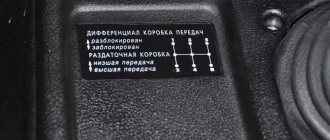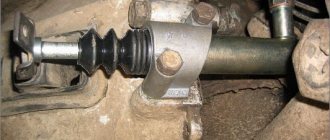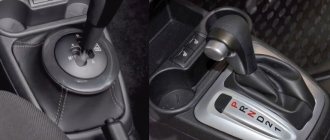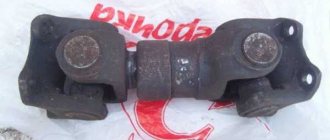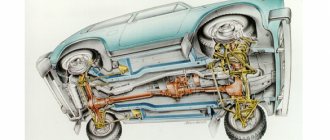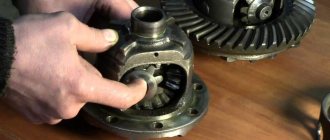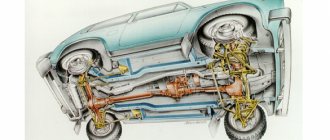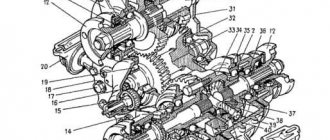Forced locking is the best type of differential lock. When unlocked, the car drives as if it were using regular, open differentials. And when locked, it provides 100% blocking of the left and right wheels of the axle. If forced locks are installed on the Niva, then in the “everything is locked” state, the car will be able to move if at least one wheel has traction with the ground.
The main disadvantage of forced blocking on Niva and Chevrolet Niva is the high cost. In addition to the blocking itself, installation of a pneumatic system and a steel front axle housing will be required. If your budget is limited, we recommend installing a “forced catch” in the front axle, because this will greatly improve cross-country ability.
Electrically driven locks on the Niva do not exist in nature. The electric drive is very unreliable, which is why even leading manufacturers of off-road equipment (for example, EPIRBs) produce only pneumatic blockers.
There are only 2 manufacturers of pneumatic blocks for Niva in the world, these are VolodyaSPB (St. Petersburg), and Slava MVN (Ukraine). At the moment we are installing MVN blocking, because... they proved to be more reliable; during life tests, not a single breakdown was registered, although they were very rigid (wheel size - 35, turned on only while driving).
PRICES:
– the pneumatic blocking itself costs 26,900 rubles.
– installation of pneumatic blocking in the front axle (in a steel body) – 28,000 rubles. in detail
– installation of pneumatic blocking in the rear axle – 6,000 rubles. in detail
– the cost of the pneumatic system with installation is from 20,000 rubles.
TOTAL (2 locks, steel body, pneumatic system) - about 110,000 rubles.
To find out the detailed cost of work, spare parts and consumables, fill out the form.
The most important positive feature of the locking device of the UltraBLOCK system, unlike other well-known systems, is that during its installation and operation no changes or modifications are made to the differential itself.
“UltraBLOCK” does not interfere with the operation of the differential gears; the blocking device is attached directly to the driven gear of the main pair of RPM with standard bolts and directly blocks the rotation of the drive relative to the driven gear of the main pair.
PASSPORT with instructions for operation and installation of FORCED ELECTROMECHANICAL LOCKING with ELECTRIC DIFFERENTIAL DRIVE OF THE FRONT AXLE REDUCER “UltraBLOCK” for LADA 4x4 “NIVA” and Chevrolet Niva
1. INTRODUCTION This passport, combined with a technical description and operating manual, contains information necessary for the installation, operation and maintenance of the UltraBLOCK forced electromechanical differential lock of the front axle gearbox. This “UltraBLOCK” kit is intended for installation on LADA 4x4 “NIVA” VAZ 21213-31, VAZ 2123 and their modifications, as well as on cars of other models, the transmission of which uses a front axle gearbox (FRM) VAZ 21215-2302010, 2123- 2302010, 21213-2302010,
| 1 | Front axle gearbox with “UltraBLOCK” system assembly | 1 |
| 2 | Internal left hinge VAZ 2123 art. 2123-2215055 (24 lengths) or VAZ 21214 art. 2121-2215055 (22 lengths) | 1 |
| 3 | Left bracket for fastening the front axle Chevrolet Niva art. 2123-2303089 or Left bracket for fastening the front axle VAZ 21214 art. 2121-2301063 | 1 |
| 4 | Electrical wiring harness | 1 |
| 5 | Controller | 1 |
| 6 | Push-button switch with panel assembly | 1 |
| 7 | Passport | 1 |
3. TECHNICAL DATA
| 1 | Rated supply voltage, V | 12 |
| 2 | Current consumption, A no more | 1,5 |
| 3 | Starting current, no more | 5 |
4. DEVICE AND PRINCIPLE OF OPERATION
The “UltraBLOK” system consists of an electric drive mechanism located on the RPM housing, a blocking device located in the RPM crankcase housing, a wiring harness, a push-button switch and a control controller.
Is it possible to disable all-wheel drive on a field?
The Chevrolet Niva SUV comes from the factory with all-wheel drive on all four wheels. The lever located under the dashboard is responsible for controlling the differential in the transfer case. ... To be able to disable the drive in order to save on fuel, it is necessary to install a shutdown unit and lock the differential.
Interesting materials:
How to record Google Translator voice on Android? How to record music via iTunes on iPhone? How to burn to CD? How to enroll a child in school in the Moscow region? How to write the system to a flash drive? How to record Stories with Android music? How to sign up for a traffic police test without a driving school? How to schedule an interview at the us embassy in Kazakhstan? How to power a light bulb from a potato? How to fill dates in Excel?
Design and principle of operation of the Niva 2121 transfer case
The transfer case mechanism includes more than 60 independent parts, which is confirmed by the presented drawing. Therefore, it is quite prudent to name the main elements and their purpose.
- Housing Differential housing Shafts Couplings Seals Pinions Gears Flanges Levers
A pair of gears are tightly seated on the drive shaft, one of them (large) is intended for high gear, the second (small) is responsible for low gear. They have serrations with straight and oblique profiles. The first ones are in contact with the coupling, the second ones - with the intermediate shaft. The inclusion of one or another row causes the coupling to move along the hub in the horizontal direction, after which it is connected to the gear on the transfer case drive shaft.
The intermediate position turns off the gearbox (the gearbox is open), and the vehicle cannot be moved in this mode. The front helical gear on the intermediate shaft is used to control the differential. The locking is engaged, or the rigid coupling of the drive shafts of both axles, is carried out through a clutch. The design is typical for modifications 21213 and 21214, and the latter is additionally equipped with a speed sensor drive.
In the operating state (with the transfer case reduction gear connected), the gear ratio in the first stage changes from 4.4 to 7.83, the second - from 2.52 to 4.58, the third - from 1.63 to 2.9, in the fourth - from 1.2 to 2.14, fifth - from 0.98 to 1.75, which is expressed in an increase in traction on the wheels.
Possible problems
Harsh operation and insufficient attention to how to use the transfer case on the Niva 2121 lead to the appearance of:
- vibrations in the body while moving;
- vibrations at start;
- hum;
- noise when maneuvering;
- tight switching modes.
Experience shows that the culprits are: insufficient oil level, incorrect centering of the steering wheel, loosening of the support fastenings and damage to the rubber bands. An additional influence is exerted by the condition of the cardan and the engine itself.
Chevrolet Niva
Locking the center differential on ice is harmful.
The exception is perhaps a slippery climb. Locking the center differential on ice is harmful. The exception is perhaps a slippery climb.
Nothing is in doubt, except, perhaps, acceleration on ice. Science says that locking should slightly improve acceleration, but in reality it turned out differently. The problem is that it is much easier to keep two wheels on the verge of slipping than four - at the same time, they slip more sharply. And even a slight slip on ice leads to a loss of acceleration efficiency.
The results are confirmed by estimates obtained on a lap and a reset - it is obvious that it is better to maneuver with the differential unlocked. But on a straight line, the rigid connection of the bridges slightly stabilizes the behavior of the car. The real help from blocking is on climbs, when the weight distribution changes and the unloaded front end is prone to slipping.
So, locking the center differential on smooth, slippery roads, with the exception of driving uphill, does not provide any advantages, and in corners it even harms, complicating controllability.
A few words about the Chevrolet Niva transfer case
I think it’s time to talk about the transfer case of the Chevy Niva, because those who just bought this car, at the very beginning of use, do not really know how to use the transfer case, what the rules are, and in general, when to lower the gear and when to lock it. Let's figure it out now. It’s a pity, of course, that I didn’t record a video on today’s drive along a fairly washed-out road. Well, never mind, I’ll record it and show it clearly on video. For now, in words.
In general, the transfer case switches to a lower gear, as well as to lock, and it is possible and even necessary to do this at the same time. It’s convenient on the Shevik - this is done with one lever.
Turn it down - right up. Add lock - Pull the lever all the way to the left. Look at the switch handle, it's written there. Letter designation - L(low) - low, N - neutral, H(high) - high, that is, normal.
It looks something like this - we are driving across the field in normal second/third gear. Suddenly there is a terrible puddle ahead. We stop and turn down the car.
You may ask - how long does it take to turn on the blocking and then turn it off? There is another nuance here - very often, many owners of the Chevrolet Niva have a problem with the blocking - it does not turn off. It just jams and that’s it, you have to drive on the highway with the blockage. This, you understand, is very harmful for the machine and in such cases you must turn it off.
In bright sunny weather it is sometimes difficult to see. Be careful. Well, about turning off the center wheel - I managed to turn it off just when reversing. Needless to say, now I turn it on only in the most dire cases. In the rest of the others, lower gears are quite enough for me.
Just today I went to the lake to check if the ice had melted. The road was washed out, the snow had already melted and turned into liquid mud, and it’s not safe to drive through such mud on my AT tires. It feels like it’s being dragged in all directions, but the most important thing is that I’m driving, I don’t get stuck, and sometimes the ruts were almost to the very bottom; when you shuffle, it always becomes unpleasant)) After some short drives, the car looked “military-like” - all covered in mud , went to the city - people look around))
And here’s another observation of mine: it’s better to drive through mud slowly but surely. This applies to lower gears - if the mud is serious, then I always drive in first, pushing hard, trying to feel the wheels spinning in the mud. If you accelerate a little, you can immediately “burrow”, this is the case when there is no hard covering under the liquid mud.
When you turn on the second lower gear, the car accelerates, but if you get into a mud hole, there is a risk that the engine will “choke” (it is very difficult to spin the wheels in the second gear when stuck) and you will stall. Needless to say, stalling in a deep puddle can be dangerous. Therefore, if you decide to overcome a puddle or muddy area with acceleration (very often this makes sense), then be prepared in the middle, if you suddenly start to fall through, immediately switch from 2 to 1 low, so as not to stall.
All this knowledge - when to go in first and when in second, when to turn on the lock and when not necessary - all this comes with experience. You’ll ride in the mud and you’ll already begin to understand that it’s better to take the puddle over there with acceleration without locking, and that clay hill with potholes - only at 1 lower gear and with the locking on. Think with your head first, and don’t rely on the car to pull it out. The Chevrolet Niva is an excellent car, if you don’t be stupid.
Therefore, one more rule (which I always adhere to) - if the place is dangerous, there is a risk of getting stuck, then get out of the car, poke it with a branch, find out the depth of the puddle, rut, feel for a solid place where you can drive. This is the job of the navigator, so let your partner get out of the car and don’t be lazy. Spend 5 minutes on reconnaissance so that you don’t have to spend several hours later getting out of an ambush.
How to change gears and transfer case Niva VAZ 21213, 21214, 2131 lada 4×4
(see also on this topic Driving a car and What is all-wheel drive, as well as Niva driving techniques)
TRANSFER CASE SHIFTING
Transfer case levers and their positions
The gear shift lever in the transfer case can occupy the following positions:
H - low gear;
N - neutral position;
B - top gear.
The differential lock lever in the transfer case can occupy the following positions:
P - differential unlocked;
B - differential is locked. When the lever is moved to this position, a warning light comes on in the instrument cluster, warning that the differential is locked.
NOTE Shifting from low to high gears and locking the differential can be done while driving with the clutch disengaged.
It is recommended to engage low gear in the transfer case after the vehicle has come to a complete stop and with the engine disconnected from the transmission.
To overcome difficult sections of the road, block the differential in advance. Do not lock the differential when the car's wheels are slipping. After overcoming such sections, unlock the differential - driving the car on good roads with a locked differential shortens the life of the power transmission mechanisms, increases tire wear and fuel consumption, and when braking the car can lead to skidding.
SHIFTING TRANSMISSION GEARS
Gear shift diagram (also printed on the handle)
Before driving, check the position of the transfer case levers - it must correspond to the road conditions. Start driving in first gear and, as the crankshaft speed increases, move to higher gears in a timely manner.
In time and in accordance with the road situation, change to a lower gear in the gearbox, avoiding overloading the engine.
To move in reverse, press the gear shift lever, pushing it all the way down and move it to the position corresponding to engaging reverse gear. Engage reverse gear only when the car is completely stopped.
Video
lada-niva.ru
Useful tips
To use the lock installed on the Niva effectively, use the following recommendations from experts:
- When driving on good quality road surfaces, install the front transfer handle at the front and the rear at the rear.
- The front handle is moved back if the road becomes slippery. Once the slippery area has been passed, switch the levers to normal mode.
- If the Niva is stopped, the lock may not engage when the clutch is depressed. This occurs due to the alignment of the teeth with the gear teeth. What should you do in this case? Moving as if on a turn, engage the lock. The differential will turn and the gear teeth will come closer to the teeth. If turning off is difficult, do it while the vehicle is moving, maintaining a minimum speed and squeezing the clutch.
How the cross-axle differential lock works on a Niva is clearly shown in the video:
Why does Niva need blocking?
Wheel differential is a mechanism that allows a car to rotate its wheels at different speeds, which does not mean changing gears, but changing when cornering, when one wheel describes a small diameter and the other a large circle. In the absence of a differential, the wheels in the Niva would begin to slip, which could result in damage and rapid wear of the rubber.
When the vehicle moves on a flat road surface, the thrust from the engine is distributed evenly to the 4 wheels.
When at least one wheel slips, which often occurs on an icy road, the differential puts more force on the slipping wheel. In other passenger cars, such a device involves installation on a drive-type axle. Niva has it in other areas:
- on the rear and front axles;
- in the center between the axles, located near the gearbox and axles.
Enabling the differential lock
On the Chevrolet Niva it is possible to turn on all three differentials at the same time . Thanks to this, the vehicle’s cross-country ability increases several times when driving off-road.
Forced locking means that the drive wheels are combined with each other, as a result of which they can rotate at the same speed. Thanks to the blocking, the traction force of the engine will be used to the maximum and transmitted to the wheels.
As already mentioned, the differential assembly consists of shafts and gears. With their help, the traction force is automatically distributed between the drive wheels. The differential is locked using a blocker (clutch) . In this case, when the driver turns on the forced locking, the wheels “become” connected to each other. This helps ensure that they rotate evenly.
Differential assembly
If the center lock is forcibly engaged, then the front and rear axles are also rigidly connected at once, which guarantees an even distribution of traction to all four wheels. Thus, the vehicle’s cross-country ability will be increased several times , which makes the Chevrolet Niva a real SUV.
Applying a lock
Not all cars are equipped with blockers, and therefore they will be vulnerable off-road. In this regard, Chevrolet is a unique car that can move with either one or all-wheel drive , which allows it to feel confident even on mountain roads.
To engage the differential lock, pull the lever all the way to the left.
Forced blocking should be enabled in the following cases:
- When overcoming difficult sections of the route. In this case, the blocking should be turned on in advance, even before leaving for such an area.
- On steep climbs or slopes when wheel slip is possible.
- When driving on sand.
- When driving on snow or ice.
Disable blocking
When the Niva moves on a regular road with a smooth surface, it will not need to lock all wheels. They will adhere normally to the surface and not slip, since the traction force from the engine will be distributed evenly over them. For this reason, when the car is moving on a good road where the wheels will not slip, the use of a differential will not be required .
Chevrolet Niva
Any Niva, even a Chevrolet, has two additional transmission options in its arsenal. The driver is free to decide whether to block the center differential or not, and can choose one of two rows of the transfer case. However, the more options there are to choose from, the greater the chance of making mistakes.
TOGETHER OR AWAY?
For example, a very common recommendation is to always turn on the center lock on icy and snowy roads. Many people believe that it improves the car's behavior on slippery roads. Let's check by measuring the car's acceleration on ice and snow, the passage of an ice circle and the speed of successfully performing a changeover on compacted snow. Skidding braking was excluded, since the condition of the center differential does not affect the braking distance. At the same time, we assessed the ease of driving and maneuverability in deep snowdrifts.
The test was held by Chevrolet Niva on Nokian HKPL R velcro tires with dimensions 205/70R15. An extract from the grade book is in the tables below.

